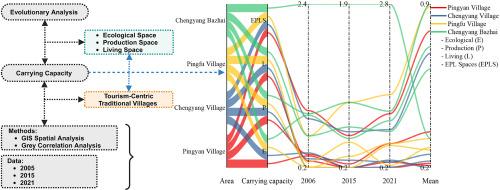广西以旅游为中心的传统村落生态-生产-生活空间承载能力演化分析
IF 8.4
2区 环境科学与生态学
Q1 ENVIRONMENTAL SCIENCES
引用次数: 0
摘要
生态生产生活空间承载能力是传统村落发展和旅游产业优化的关键。然而,对中国以旅游为中心的传统村落的研究仍然有限。本研究通过考察中国广西以旅游为重点的村庄的生态系统承载能力来解决这一差距。利用城阳坝寨遥感影像,结合当地旅游和社会经济发展数据,对不同类型的生态系统进行了分类,并建立了综合指标体系。采用地理信息系统空间分析方法,结合灰色关联分析,对青浦区生态系统承载力演变及其影响因素进行了评价。结果表明:2006 ~ 2015年,生态系统总体承载能力呈下降趋势;生产空间承载力保持相对稳定,生态空间和生活空间承载力明显下降。然而,从2015年到2021年,eps的承载能力大幅增加。平岩村的增长最为显著,其次是城阳村,平府村的增长最小。旅游业的发展显著影响了青岛区生态系统承载能力的演变,因此更需要策略性的未来规划。优化生态承载力,实现旅游可持续发展,需要不断提高生态承载力,减少承载力与旅游增长之间的负交互作用,实现生态振兴。本研究有助于加深对eps承载能力的理解。为城阳旅游资源优化提供理论指导,为类似地区旅游可持续发展提供实践启示。本文章由计算机程序翻译,如有差异,请以英文原文为准。

Evolutionary analysis of ecological-production-living space-carrying capacity in tourism-centric traditional villages in Guangxi, China
The carrying capacity of ecological-production-living space (EPLS) is pivotal to the development of traditional villages and the optimization of their tourism industries. However, research on tourism-centric traditional villages in China remains limited. This study addresses this gap by examining EPLS carrying capacity in tourism-focused villages in Guangxi, China. Using remote sensing imagery of Chengyang Bazhai (CYBZ) along with data on local tourism and socio-economic development, the study classifies different types of EPLS and establishes a comprehensive indicator system. Geographic information system spatial analysis, combined with grey correlation analysis, was employed to assess the evolution of EPLS carrying capacity and its influencing factors in CYBZ. The findings indicate that between 2006 and 2015, the overall carrying capacity of EPLS experienced a decline. While the carrying capacity of production spaces remained relatively stable, ecological and living spaces saw notable decreases. However, from 2015 to 2021, EPLS carrying capacity increased substantially. The most substantial growth was observed in Pingyan Village, followed by Chengyang Village, with Pingfu Village exhibiting the smallest improvement. The expansion of the tourism industry has significantly influenced the evolution of EPLS carrying capacity in CYBZ, creating a greater need for strategic future planning. Optimal EPLS and durable tourism development require continuous enhancements in EPLS capacity, reductions in negative interactions between carrying capacity and tourism growth, as well as ecological revitalization. This study contributes to the existing literature by enhancing EPLS carrying capacity understanding. It offers theoretical guidance for its optimization in Chengyang and practical insights into sustainable tourism development in similar regions.
求助全文
通过发布文献求助,成功后即可免费获取论文全文。
去求助
来源期刊

Journal of Environmental Management
环境科学-环境科学
CiteScore
13.70
自引率
5.70%
发文量
2477
审稿时长
84 days
期刊介绍:
The Journal of Environmental Management is a journal for the publication of peer reviewed, original research for all aspects of management and the managed use of the environment, both natural and man-made.Critical review articles are also welcome; submission of these is strongly encouraged.
 求助内容:
求助内容: 应助结果提醒方式:
应助结果提醒方式:


